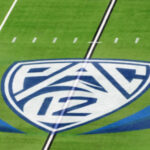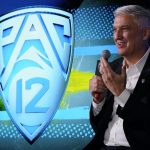The Hotline mailbag publishes weekly. Send questions to pac12hotline@
Please note: Some questions have been edited for clarity and brevity.
Any chance the Pac-Whatever would eventually get back together for all sports besides football? — @kentura82
Great timing for the question given that Arizona’s loss to Clemson on Thursday night was the last men’s basketball game played under the Pac-12 name.
As 10 schools go their separate ways, Washington State and Oregon State will compete as affiliate members of the West Coast Conference for at least two seasons.
Our view: There’s a very good chance basketball and other Olympic sports are reconfigured along regional lines in the next five years.
WSU and OSU could rebuild the conference in the near term with schools from the Mountain West. But eventually, some, and perhaps all of the 10 outbound members will regroup under the Pac-12 banner.
Maybe it’s the Pac-12. Or the Pac-16. Or the Pac-20. It’s unknowable at this point, and the specifics are irrelevant.
Nobody in college sports believes the power conference structure in place for 2024-25 is sustainable, or smart. And everybody believes that the industry will be turned on its head in the next 18-to-24 months when athletes are declared employees, thereby changing the economics supporting athletic departments across the country.
(Some schools will be all-in with paying salaries. Some will have difficult decisions to make. Others simply won’t have the wherewithal to devote the necessary resources.)
In fact, conference realignment — a polished way of describing the insatiable quest for every last dollar — has illuminated the hypocrisy in the NCAA’s amateur model and expedited the legal challenges to said model.
When you’re scheduling conference games 2,000 miles from home on a Wednesday because one conference offered a better TV deal than another, amateurism is dead.
Many believe football, the prime money-maker and the driver of realignment, should be treated differently from the other sports. And because of the limited number of conference games, it doesn’t carry the same travel rigors as basketball or soccer, for example.
Perhaps a super league forms, featuring 24 or 36 teams. Maybe the Big Ten and SEC continue to distance themselves from the remaining 100 schools within the FBS structure. Both models can be justified.
What cannot be justified: Utah at UCF in softball, Oregon at Purdue in women’s basketball or UCLA at Rutgers in anything.
It’s all preposterous, and the folks in charge know it’s preposterous.
Maybe it takes four years for sanity to return. Or six. Either way, the Hotline would be quite surprised if the 2030s begin and Oregon is traveling to Purdue for a conference game in anything other than football.
Can Washington State and Oregon State afford to wait too long before they start inviting teams? With their new NCAA credits windfall and conferences jockeying for media deals in the near future, don’t the ‘Pac-2’ schools need more clarity soon? — @mlondo856
While it feels like speed is of the essence, I would flip the issue: Can they afford to not wait?
Can the Cougars and Beavers afford to relinquish their flexibility with the landscape evolving rapidly (as discussed above) and nobody sure of the end result?
If the schools knew the ACC was going to remain intact or break apart, if they knew the outcomes of lawsuits and legal challenges, if they knew the Big 12 was finished expanding for the rest of the decade, then the calculation would change.
But because the future — not only for the ‘Pac-2’ but for everyone — is unclear, the Cougars and Beavers must remain as flexible as possible for as long as possible.
They have one deadline: By the summer of 2026, WSU and OSU must add at least six schools to the Pac-12 or join another conference (likely the Mountain West).
That gives them until the middle of 2025 (approximately) to determine their course of action. I doubt the uncertainty will last that long. By next spring, the next move should be clear.
For now, staying flexible is their best bet.
Can you please ask retired Fox Sports president Bob Thompson to provide an estimate of the current media valuation for the Big Ten schools excluding Ohio State, Michigan, Penn State and the L.A. tandem? Do the remaining 13 have a media value that’s close to the $30 million (per school) of the Big 12 and the Pac-12 (without USC and UCLA)? — @Jalex0077
I will pose the question to Thompson at some point, but the list of “remaining 13” schools would include Oregon, Washington, Michigan State, Iowa, Wisconsin and Nebraska.
Those are quality football brands with large alumni bases and passionate followings. As a collection, they are more attractive to the networks than the top six in the Big 12 or ACC.
Of course, the rest of the remaining Big Ten schools (Minnesota, Illinois, Purdue, Indiana, Northwestern, Maryland and Rutgers) would carry below-average valuations.
My suspicion is that Thompson’s math would project the ‘Big 13’ somewhere above $30 million but maybe not all the way to $40 million.
It’s an interesting exercise, for sure.
All three West Coast teams in the Sweet 16 were assigned the early tipoff slots (approximately 4:10 p.m.). Is that to keep the East Coast audience glued to their sets until after midnight their time while sacrificing the West Coast viewers? — @halverbk
I suspect the television schedule was all about placing North Carolina and Duke on CBS in prime time on the East Coast, which in this case is the 9 p.m. ET tipoff.
And if the Tar Heels and Blue Devils were slotted for those windows on Thursday and Friday, respectively, it seems likely that Turner would not want the second-best game of the night (from a viewership standpoint) at the same time.
Put another way: If North Carolina is the main event Thursday on broadcast TV, then Connecticut takes the early window on cable; and if Duke is the main event Friday, then Purdue goes early.
All the other games on both days would flow from there.
There might be other reasons, but that makes the most sense to me.
How did Washington hire a basketball coach before an athletic director? Was there communication between Danny Sprinkle and Pat Chun before all the news dropped? Or are they showing up on campus like freshmen moving into their dorms for the first time? — @HighlightEel
Good question, because Washington’s situation was unusual — both in the nature of the concurrent vacancies and the speed with which they were filled. Sprinkle was named on Monday, Chun appointed on Tuesday.
The process made sense on two fronts: The basketball search began before former athletic director Troy Dannen left for Nebraska, and it carried more urgency because of the potential for players to leave through the transfer portal.
That said, Chun spoke with former Washington athletic director Jen Cohen about the vacancy last week. (They are good friends.) Via that back-channel conversation, the Huskies knew he would be open to the idea and, at some point, Chun assuredly knew the direction of the basketball search.
I doubt he spoke to Sprinkle before Sprinkle was announced as head coach on Monday. That would not have been appropriate. But we would bet heavily that each was aware of UW’s plans for the other position before it was officially filled.
When might this crazy NIL money for college athletes slow down? — @MrEd315
It will slow down when athletes are deemed employees, which should happen in the next 18-24 months — either voluntarily or by court order.
That momentous step won’t end the NIL (name, image and likeness) economy; athletes will still sign endorsement deals. But it will alleviate some of the pressure to pursue NIL with abandon through the transfer portal and in the recruiting process.
What will be your first Big Ten road trip? — @dawgsrback
I haven’t mapped out game coverage yet, largely because the kickoff times won’t be announced until the spring. (There’s also a chance that Big Ten games currently scheduled for Saturday could be moved to Friday.)
However, the Hotline’s first road trip likely will be the Big Ten football media kickoff event in Indianapolis, scheduled for three days in late July.
Why do you call it the Hotline when it’s just you? This question remains unanswered. — @UWCRITTER
Appreciate the question. And if you knew how the sausage gets made on the Hotline, you would probably wonder, ‘How in the hell does the sausage ever get made?’
The Hotline was created in the mid-2000s, as the College Hotline blog. The name came courtesy of my former colleague and forever friend, Tim Kawakami. He suggested the ‘Hotline’ portion because it was both catchy and fit the reporting strategy I had planned. And he couldn’t have been more prescient.
The name stuck for more than a decade as I focused on the Pac-12 and everything that went right, then sideways, then wrong with the conference.
In the summer of 2017, we switched to Pac-12 Hotline after receiving permission from the conference itself to use the name. I’m sure many folks at HQ later regretted their gesture as we focused on the financial woes, the misguided media strategy and the operational gaffes (e.g., the instant replay mess of 2018).
This operation has carried the Hotline name for 18 years but the Pac-12 piece for just seven.
At some point this spring, we’ll drop Pac-12 and either return to College Hotline or Wilner Hotline, which is my Twitter/X handle.
But the content won’t change: As was the case before Pac-12 was added to the name, the focus will be on the 12 schools and the issues that matter to them.
Because the upheaval that has roiled college sports in the past two years will seem like amateur hour compared to what’s coming in the next three years.
The Hotline’s service to readers is more important than ever.
*** Send suggestions, comments and tips (confidentiality guaranteed) to pac12hotline@bayareanewsgroup.
*** Follow me on Twitter/X: @WilnerHotline
*** Pac-12 Hotline is not endorsed or sponsored by the Pac-12 Conference, and the views expressed herein do not necessarily reflect the views of the Conference.
Related posts:

(AP Photo/Ralph Freso, File)
Mailbag: Explaining Oregon vs. Liberty, Baker’s proposal, the ‘Pac-2’ and Power Five status, the 2004 controversy and more Pac-12 legal saga: OSU, WSU block mid-year revenue payments to 12 campuses as massive liabilities loom
Pac-12 legal saga: OSU, WSU block mid-year revenue payments to 12 campuses as massive liabilities loom

(AP Photo/Marcio Jose Sanchez)
George Kliavkoff speaks: Pac-12 commissioner blames the schools for lacking patience, takes credit for Pac-12 football success Wilner – Arizona, ASU search for new athletic directors: For both schools, challenges looms as college sports prepare for a new era
Wilner – Arizona, ASU search for new athletic directors: For both schools, challenges looms as college sports prepare for a new era

